1997 Results
Our first official field
season was during the summer of 1998. Because it takes much longer
to measure the data and figure out the results than it does to collect
the data, we are working hard to get some information available soon.
When it happens, you can find it in the recent findings page.
In 1997, we collected
preliminary data. These initial findings come under three main categories:
1) treeline advance, 2) growth form, and 3) fire disturbance. These
categories are very closely related to our 3 major questions that
you can read if you click here.
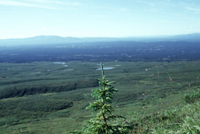 |
1)
Is treeline advancing?
At 2 of our 3 sites during the 1997 field season,
we noticed the pattern in the graph below.
|
(Learn about age
structures or treeline
first, if you haven't already, to help understand the graph).
|
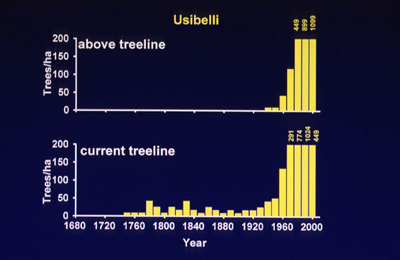
|
Explanation:
On the y-axis (the vertical axis), the "Trees/ha"
shows density: how many trees were there in a certain area?
On the x-axis (the horizontal axis), the "Year" shows
what year each tree started to grow. The yellow bars show how
many trees started growing in each given year. Notice that we
did age structures for trees above treeline and trees at current
treeline so we can compare them. At this particular site, one
might suspect that treeline is advancing.
Why?
Trees at treeline seem to have been around a long time (notice
the years that some of them established. But look at above treeline:
in the (upper) above treeline graph, there aren't any trees
older than 70 years and the trees since 1940 are numerous. Because
there are trees growing above treeline where they probably haven't
grown before, we suspect that treeline might be advancing. Why
don't we know for sure? At this particular place, treeline may
be advancing, but until we look in a bunch of other places,
we won't be able to generalize about everywhere else. Perhaps
treeline is advancing only in some places or it is advancing
at different speeds in some places. Stay tuned!
|
 Listen to Dr. Andrea Lloyd
describe the data on treeline advance. Click
here for
text. Listen to Dr. Andrea Lloyd
describe the data on treeline advance. Click
here for
text.
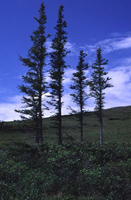 |
2)
Is tree growth form changing?
At 3 of our 3 sites during the 1997 field season,
we noticed the pattern below.
(Learn about growth
form first, to help understand the graph below.)
|
|
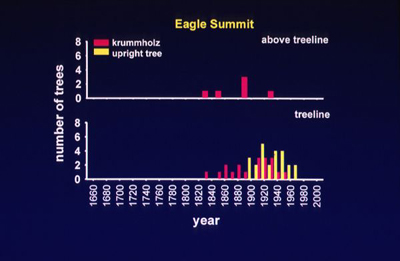
|
|
Explanation:
This graph is very much like the one above. On the y-axis
(the vertical axis), the "Trees/ha" shows density--
how many trees there were in a certain area. On the x-axis
(the horizontal axis), the "Year" shows what year
each tree started to grow. The pink and yellow bars show how
many trees started growing in each given year. Again, notice
that we did age structures for trees above treeline and trees
at current treeline so we can compare them. But because there
are both pink and yellow bars, we can learn more than just
information about age structure: we can learn about growth
form. The pink bars are twisted "krummholz" growth
forms, while the yellow bars are upright spruce trees.
What can we learn? Notice that only krummholz trees grow
above treeline. Does this make sense? Why should there be
more krummholz trees above treeline? Also notice the treeline
graph (the bottom one): lots of krummholz trees started growing
a long time ago (pink bars only), but there are upright trees
that start establishing later in the 20th century (yellow
bars). This change-over suggests that growth form is changing
at this site. Why might it be changing? It may have to do
with climate change: a warmer climate with easier growing condition
and less harsh conditions might allow spruce to grow straighter
and taller. Click here
to view another growth form graph.
|
 Click here to
listen to Dr. Andrea Lloyd describe growth form.
Click here
for text. Click here to
listen to Dr. Andrea Lloyd describe growth form.
Click here
for text.
|
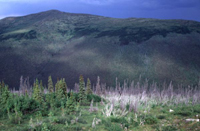
|
3)
What's been the role of fire disturbance?
One of our study sites showed no sign that treeline
was advancing.
|
|
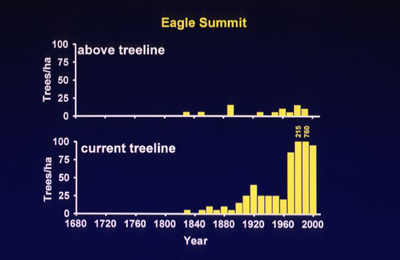
|
| Explanation:
this graph is the same type as the first one; the difference
is in the information. At treeline, spruce seem to be establishing
very well (lots of new seedlings), but above treeline, there
are no new "pulses" of establishment (meaning that
lots of seedlings aren't starting to grow). Why? One possibility
lies in the history of this site. We know from records that
the site burned some time ago. Did this fire keep spruce from
expanding? Remember that fire might have a positive effect
on spruce establishment (clearing away competition, removing
the unwanted organic soil layer), but it might also have a
negative impact on spruce establishment (clearing away the
protection from the wind, ice, and cold). What is the real
case? It may differ from place to place, so we need to collect
information from other sites. Stay tuned! (And click here
to learn about how we are testing this by planting seedlings
in burned and unburned areas.) |
 Listen to Dr. Andrea Lloyd
describe how we planted seedlings. Click here
for text. Listen to Dr. Andrea Lloyd
describe how we planted seedlings. Click here
for text.
|





